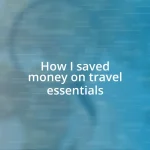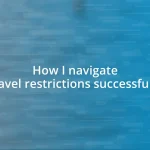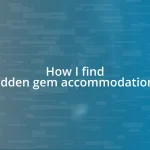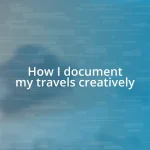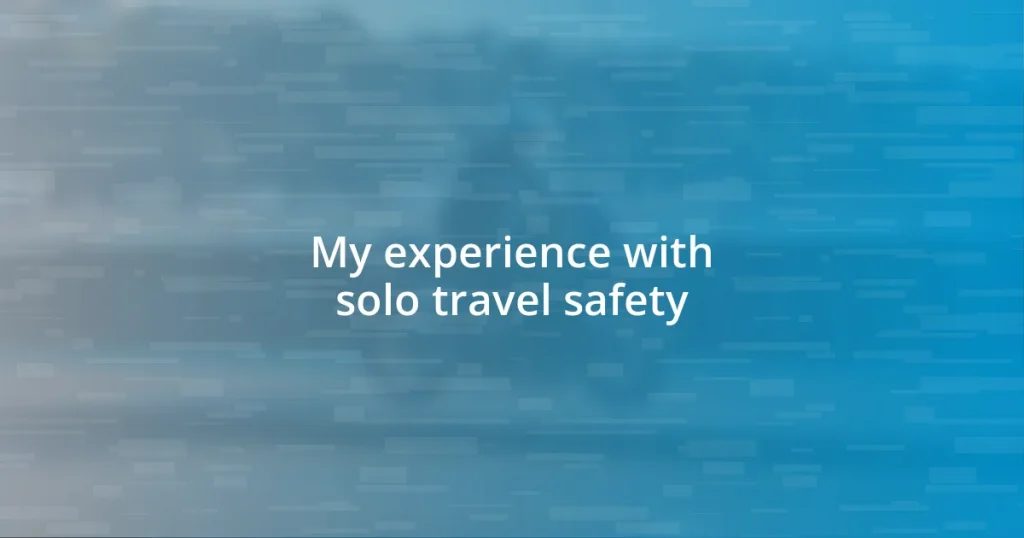Key takeaways:
- Define your travel goals early to tailor your itinerary around enriching experiences that resonate with you personally.
- Utilize technology and local insights to enhance your travel planning, uncovering unique activities and maximizing spontaneity.
- Balance structured activities with downtime to allow for reflection and genuine connection with your surroundings, creating lasting memories.

Determine your travel goals
Determining your travel goals is essential for crafting the perfect itinerary. Reflecting on what excites you most about travel can guide your planning. For instance, during my last trip to Italy, I realized that my main goal was to immerse myself in local culture rather than just checking off tourist spots.
Have you ever felt overwhelmed by the countless destinations you could explore? It helps to think about what you truly want from your journey. Are you seeking relaxation, adventure, or perhaps meaningful experiences with new friends? When I prioritized spending time with locals and trying their homemade dishes, I ended up creating some of my most cherished memories, like learning to make pasta from a sweet grandmother in Tuscany.
It’s also worth considering how you want to feel during your travels. Are you looking for inspiration, peace, or excitement? I remember standing on the cliffs of Santorini at sunset, feeling utterly alive, and it became evident how a simple goal of finding breathtaking views could enhance my experience immensely. Each trip can be a unique journey, so take the time to clarify your aspirations—it’s a game changer in your itinerary planning!

Research your destination thoroughly
Researching your destination thoroughly is a vital step in crafting an unforgettable itinerary. I often start by diving into travel blogs and forums to absorb firsthand accounts and hidden gems that aren’t in conventional guides. For instance, before my recent trip to Japan, I stumbled upon a blog detailing a local cherry blossom festival that wasn’t widely advertised. This insight added a unique experience to my itinerary that turned out to be a highlight of my journey.
When researching, consider not just the popular attractions but also the local customs and cultural nuances. I remember arriving in Morocco, feeling completely unprepared for the spicy cuisine and vibrant street markets. However, understanding the cultural significance of the food helped me appreciate every bite and interaction with locals. By delving into customs, I was able to ask locals about their favorite dishes, leading to delightful culinary adventures off the beaten path.
I recommend creating a comparison table to evaluate aspects of your destination, such as climate, budget, and activities. This method not only clarifies what you’re most excited about but also helps in making informed decisions. I’ve found that breaking down the factors visually can reveal aspects I previously overlooked, enhancing the overall planning experience.
| Destination Factor | Details |
|---|---|
| Climate | Best months to visit |
| Budget | Typical costs for food and lodging |
| Activities | Must-see attractions and experiences |

Create a flexible daily schedule
Creating a flexible daily schedule can be a game changer when traveling. I’ve learned that while it’s essential to have some structure, leaving room for spontaneity often leads to unexpected adventures. For instance, during a trip to Barcelona, I had planned a packed itinerary featuring major sights like the Sagrada Familia, but I made sure to keep my afternoons free. This flexibility allowed me to wander into a quaint little café where I met a local artist, sparking a delightful conversation that led to an impromptu guided tour of the city’s lesser-known art galleries.
Here are some strategies to ensure your schedule remains flexible:
- Prioritize Must-See Attractions: Identify a few must-visit spots but stay open to altering your plans based on mood or weather.
- Allocate Buffer Times: Include buffer times between activities to account for delays or opportunities you might stumble upon.
- Check Local Events: Research any local events or festivals that might arise during your visit, and be willing to shift plans to experience them.
- Listen to Your Instincts: If you feel like spending more time in a beautiful park or an intriguing shop, allow yourself to deviate from your schedule.
- Plan Shorter Activities: Opt for shorter activities in the afternoon, which allows for flexibility while still ensuring you accomplish what you set out to do.
By crafting a flexible daily schedule, you’ll find that the journey becomes just as enjoyable as the destination itself!
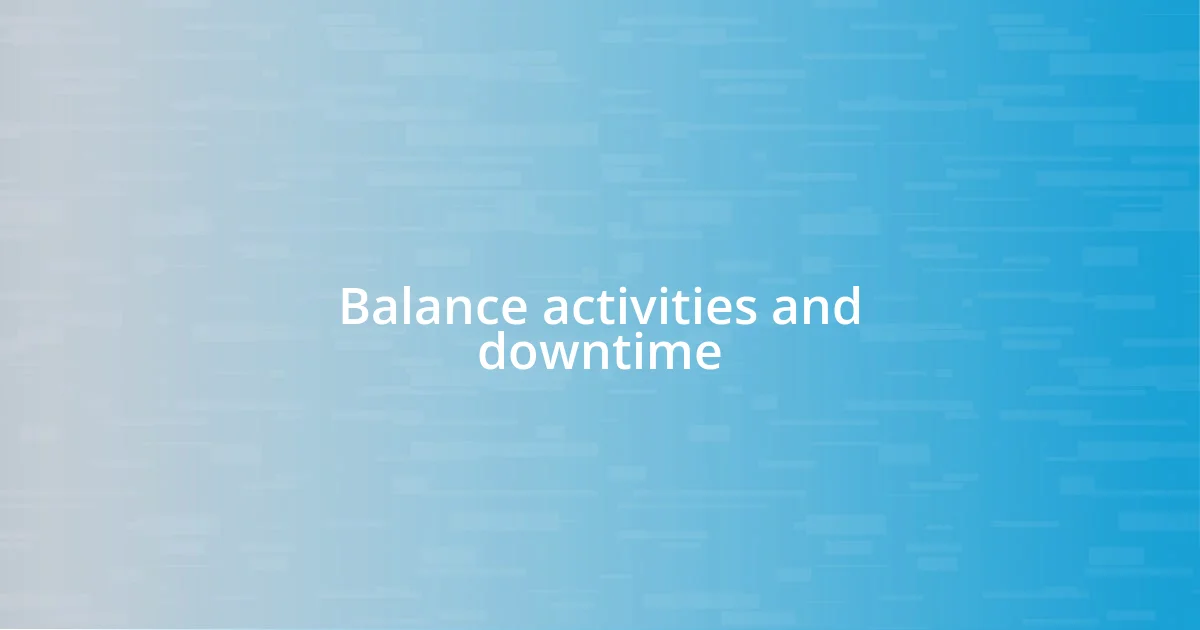
Balance activities and downtime
It’s crucial to strike a balance between a packed itinerary and some much-needed downtime. I’ve found that if I schedule too many activities, I end up feeling exhausted rather than exhilarated. During one trip to Italy, I overscheduled my days, rushing from one historic site to another without allowing time for reflection or enjoyment. One afternoon, after a whirlwind morning in Florence, I decided to simply sit on a park bench with a gelato, soaking in the atmosphere. That moment became a treasured memory, teaching me the value of pausing amidst chaos.
In my experience, mixing high-energy activities with quiet moments can rejuvenate your travel spirit. For instance, when I visited New Orleans, I filled my mornings with vibrant walking tours, yet my afternoons were reserved for leisurely strolls through hidden gardens or cozy cafés. This rhythm of exploration followed by relaxation made my trip more fulfilling. Have you ever found that taking a moment to breathe can help you appreciate your surroundings more? I certainly feel that way when I allow myself to connect with the local scene — it’s where deeper experiences flourish.
Remember, downtime isn’t just about resting; it’s an opportunity to reflect on and digest your experiences. On a recent trip to Greece, I dedicated a couple of evenings to simply enjoying sunset views from a quiet spot on the beach. Those moments of tranquility allowed me to appreciate the beauty around me and transformed my travels from just sightseeing to creating lasting memories. So, consider how important those calm moments can be in your itinerary; they just might be the juice that energizes your adventures!

Use technology for planning
Utilizing technology for planning has truly enhanced my travel experiences. I often rely on apps like Google Maps and TripIt, which consolidate all my itinerary details. A while ago, during a trip to Japan, I appreciated how real-time navigation helped me effortlessly explore Tokyo’s intricate subway system, allowing me to focus more on the incredible sights rather than getting lost.
More than just maps, tech tools can enhance spontaneity too. I remember one evening in Paris when I stumbled upon an intriguing event at a local art gallery. With a quick search on Eventbrite, I found just what I was looking for and bought tickets on the spot. It struck me then how technology not only helps plan but also enriches our journeys by connecting us with local experiences we might otherwise miss.
The magic really happens when you embrace the right digital tools for your travel needs. For instance, I swear by travel blogs and social media platforms for up-to-date recommendations on must-try restaurants or hidden gems. Have you ever found a place that felt like a secret treasure? I certainly have. While researching for my last trip, I discovered a tiny sushi bar recommended on Instagram, and it turned out to be a highlight of my trip! Engaging with technology in this way opens up a world of possibilities that I never want to travel without.

Gather local insights and tips
Gathering local insights and tips is one of the most enriching aspects of travel. I remember wandering through the winding streets of Lisbon and striking up a conversation with a local artist. He not only shared his favorite hidden fado spots but also invited me to an art show that evening. That spontaneous connection turned into an unforgettable night filled with music and culture, something I would have missed without his guidance.
I’ve noticed that the best recommendations often come from those who live in the area. During a trip to Mexico City, a barista at a café suggested I visit a lesser-known market. Initially skeptical, I decided to follow his advice, and I was blown away by the vibrant atmosphere and authentic food. Plus, mingling with the locals while sampling fresh tamales was a highlight of my journey—it’s moments like these that help you feel the pulse of a city.
Don’t underestimate the power of social media in your quest for local wisdom. I’ve found that asking for tips in travel forums or even Instagram stories can yield amazing results. On my latest adventure to Vancouver, I reached out for recommendations and discovered a breathtaking viewpoint that wasn’t on any tourist map. Had I not asked, I would have missed out on capturing some of the most stunning sunset photos of my life. So, the next time you’re planning a trip, consider reaching out—sometimes the best experiences come from a simple question!

Review and adjust your itinerary
Reviewing and adjusting your itinerary is a crucial step that I often revisit throughout my travel preparation. After all, what if a new attraction pops up or a local festival changes the availability of certain activities? Just recently, while planning a trip to Rome, I stumbled upon an unexpected culinary event that hadn’t been on my radar. I quickly revised my plans to include a cooking class that turned out to be one of the highlights of my time there.
Sometimes, I find that a little reflection goes a long way. After my first pass at an itinerary, I like to sit down with a cup of coffee and think about how those plans make me feel. Does it excite me? Or does it feel too rushed? During my trip to Thailand, I initially filled my days with activities but realized I was exhausting myself. By adjusting my plans to incorporate more downtime, I was able to truly appreciate the serene beauty of the islands—something I almost missed in my eagerness.
It’s all about balance, right? I also recommend discussing your plans with a travel buddy if you have one. Sharing your itinerary often reveals new perspectives and sparks that creative thinking. I remember when a friend pointed out that instead of visiting a popular tourist spot, we could explore a lesser-known temple, which brought us a more peaceful and genuine experience. This small tweak transformed our trip. How do you approach your own travel reviews?





